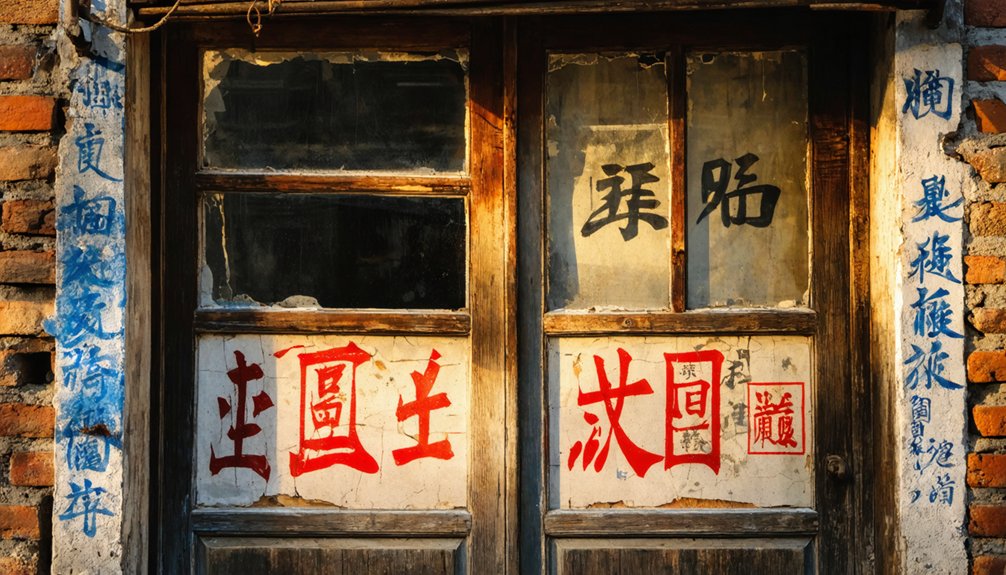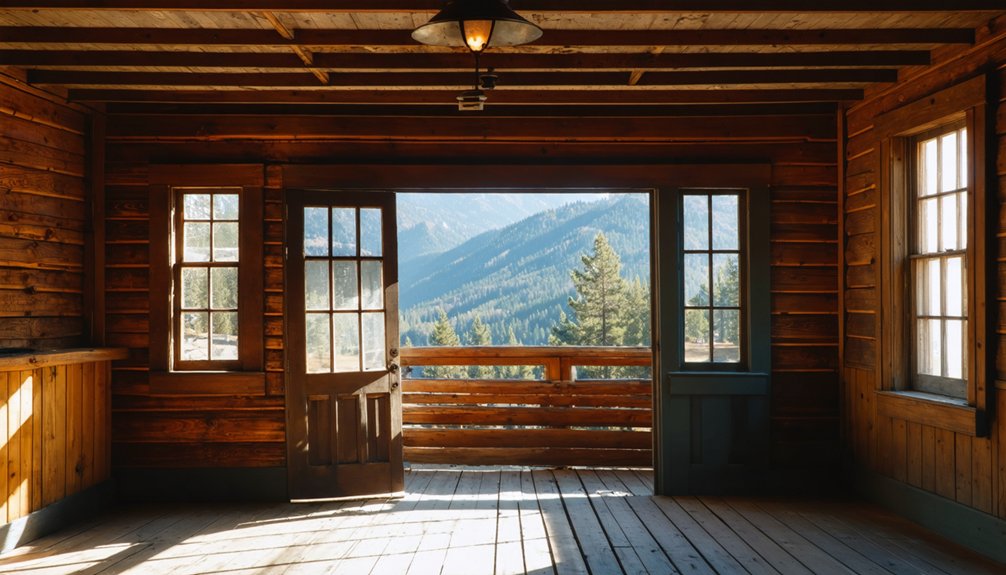Progress, California emerged during the 1849 Gold Rush when fortune-seekers flocked to the Sierra Nevada foothills. You’ll find rusted machinery and abandoned buildings that tell the story of technological evolution from simple panning to industrial mining operations. The town’s diverse community—Americans, Europeans, and Chinese immigrants—created a unique cultural tapestry before dwindling resources led to abandonment. Walk these weathered streets and you’ll step back into California’s golden era.
Key Takeaways
- Progress emerged during the California Gold Rush after 1848, attracting international fortune-seekers to mine the Sierra Nevada.
- The town evolved from simple panning operations to advanced hydraulic mining and industrial drilling as surface gold depleted.
- Diverse cultural districts formed, with ethnic enclaves like Chinatown and Cornish neighborhoods creating a multicultural frontier community.
- Progress declined when mining became economically unviable, with depleted gold deposits causing population migration and infrastructure deterioration.
- Grassroots preservation efforts now document Progress’s mining heritage without government support, protecting authentic remnants of California’s gold rush era.
The Gold Rush Origins of Progress
While James W. Marshall’s discovery at Sutter’s Mill on January 24, 1848, ignited the California Gold Rush, it was the fever that followed that birthed Progress.
You can trace this ghost town’s origins to the waves of forty-niners who abandoned their previous lives, seeking fortune in the Sierra Nevada’s ancient riverbeds.
Like thousands of settlements that sprung up overnight, Progress emerged as prospectors rushed to extract gold using panning and coyoteing techniques.
The town swelled with international fortune-seekers—Americans mingling with Europeans, Latin Americans, and Chinese immigrants. By 1849, women made up only 700 of 40,000 arrivals by ship, creating a predominantly male society.
This gold fever transformed California’s landscape, with Progress standing as a reflection of humanity’s eternal quest for wealth and opportunity.
Today, Progress’s abandoned structures remind you of a mining legacy that extracted an estimated 370 metric tons of gold within just five years—a freedom-fueled frenzy that forever changed American history.
As the gold became harder to find, individual miners struggled against the rising corporate mining operations that gradually made small-scale prospecting unsustainable.
Mining Operations and Economic Backbone
As you walk among the rusted machinery scattered throughout Progress, you’ll notice the technological evolution from simple pickaxes to elaborate stamp mills that once thundered day and night.
These innovations allowed miners to extract gold from increasingly stubborn quartz veins, though diminishing returns eventually challenged even the most sophisticated operations. The town’s economic viability depended on the gold-backed currency that stabilized the regional economy during its peak years. The prosperity once found here mirrors California’s historic identity as the Golden State, officially recognized in 1968 but earned through discoveries like James Marshall’s in 1848.
The town’s prosperity rose and fell with these technological battles against nature, as each advancement briefly rekindled hope before the inevitable confrontation with finite resources.
Mining Technology Evolution
When you explore the ruins of Progress, you’re witnessing the evolution of an industry that transformed not only this settlement but the entire American West.
What began with simple pans and cradles for surface mining quickly advanced to massive hydraulic operations that literally moved mountains with pressurized water cannons throwing 185,000 cubic feet of water hourly.
As surface deposits depleted by 1854, miners drove deep into the Mother Lode, employing Cornish pumps and stamp mills where once only picks and shovels sufficed.
The hydraulic advancements that once dominated Progress were eventually silenced by the 1884 federal injunction, their environmental toll deemed too great.
The technological progression from pan to industrial drill charts not just Progress’s rise and fall, but the Gold Rush’s transformation from individual freedom to corporate dominance.
This transition mirrors California’s broader pattern from simplistic placer mining to today’s AI-enhanced extraction techniques, demonstrating remarkable technological advancement over nearly two centuries.
These engineering achievements required extensive foundry operations that transformed San Francisco’s Iron District into a manufacturing powerhouse supporting the mining industry throughout the region.
Resource Extraction Challenges
The unforgiving terrain surrounding Progress presented miners with challenges that would have broken less determined souls.
You’d have marveled at their tenacity as they carved transportation routes along treacherous cliffs, hauling precious silver and lead ore through narrow canyon passages.
Mining hazards lurked at every turn—unstable shafts, primitive equipment, and the constant threat of collapse.
Labor shortages plagued operations as the town’s remote location deterred all but the most adventurous spirits.
When the Owens Valley Paiute actively resisted expansion between 1865-1877, progress stalled until military intervention cleared the way.
The town’s economic significance ebbed and flowed with mineral yields and market prices, its fortune tied directly to what could be extracted from Montana Peak’s resistant geology.
Freedom came at the cost of constant struggle against nature’s constraints.
Similar to Castle Dome City, Progress became known for its rich silver production that ultimately couldn’t sustain the town through changing economic conditions.
The ore extracted from mines typically formed heavy 80-88 pound bars that contained varying percentages of silver mixed with lead and other impurities.
Daily Life in a Booming Frontier Town
You’d barely recognize yourself amidst Progress’s notorious saloon brawls, where miners spent hard-earned wages after sixteen-hour shifts underground.
Behind the town’s economic prosperity lurked constant hardship—disease, accidents, and the ever-present threat of claim jumpers that could instantly transform fortune into ruin. Like many settlements during the Gold Rush era, Progress experienced dramatic cycles of prosperity followed by decline when resources became scarce. Similar to Calico, the town was eventually designated a ghost town when mining operations ceased and residents departed.
The streets echoed with Dutch, English, and Cantonese conversations as Progress cultivated one of California’s most diverse frontier communities, with separate cultural districts forming around the mining operations.
Rowdy Saloon Gatherings
Deep within the heart of Progress, California, rowdy saloon gatherings defined the frontier town’s social rhythm, creating a vibrant tapestry of human interaction unmatched in other settings. The wooden-framed establishments became your portal to freedom after grueling days in the mines.
- You’d witness class boundaries dissolve as miners, prospectors, and transients shared tables, exchanging tales of strikes and failures across saloon culture’s democratic floors.
- Your evenings filled with card games and dice throws while musicians performed on makeshift stages, the nightlife entertainment fueling the town’s economy.
- You’d form business partnerships over whiskey, sealing mining deals with handshakes rather than contracts.
- You’d experience the rush of celebration when new discoveries brought prosperity, the saloon transforming into the beating heart of collective joy.
Hardship Behind Prosperity
Beyond the gleaming glasses and raucous laughter of saloon revelry existed a stark reality few visitors to Progress recognized until they’d lived through a season of frontier existence. The veneer of opportunity quickly faded once you experienced the brutal conditions firsthand.
Sixteen-hour workdays in mines became your norm, with labor exploitation disguised as fair wage. Your body aged decades in mere years, hunched over and damaged by relentless toil underground.
The surrounding landscape bore similar scars, as environmental degradation transformed pristine wilderness into barren, toxic terrain. Waterways ran orange with mine tailings, while forests vanished for timber frames and fuel.
You’d watch as company doctors charged exorbitant rates for treating injuries sustained while enriching distant owners—freedom promised, but bondage delivered through debt and necessity.
Multicultural Mining Community
Walking down Front Street in Progress during the 1870s, you’d encounter a tapestry of languages, customs, and faces unlike anything east of the Mississippi. This multicultural mining community forged its identity through daily interactions between Chinese, European, Mexican, African American, and Native American residents.
Each group contributed uniquely to Progress’s vibrant social fabric:
- Ethnic enclaves formed organically—Chinatown with its laundries and herb shops, Cornish miners in their tight-knit neighborhood sharing traditional pasties.
- Improvised pidgin languages emerged for commerce, allowing communication across cultural divides.
- Local saloons served as unofficial town squares where miners exchanged mining techniques and cultural traditions.
- Religious ceremonies and festivals punctuated town life, from Chinese New Year to Irish wakes.
Despite discrimination’s harsh reality, these multicultural interactions created an unexpectedly rich frontier society.
Cultural Diversity and Social Dynamics

Amidst the crumbling facades and weathered structures of Progress, California, one finds a remarkable tapestry of cultural heritage that once defined this now-silent settlement.
While records specifically about Progress remain limited, its story likely mirrors neighboring mining towns where diversity thrived.
You’ll find parallels in places like Bodie, where Chinese immigrants operated laundries and merchants, Chilean miners extracted precious metals, and European craftsmen plied their trades.
These communities typically held vibrant ethnic celebrations, with traditional music echoing through saloons and churches hosting community gatherings that transcended cultural boundaries.
Mining towns fostered unique social dynamics where necessity often overcame prejudice.
The shared struggles of harsh desert living and dangerous mining work created bonds that cut across ethnic lines, forming a resilient community united by the pursuit of prosperity.
The Descent Into Abandonment
As the nineteenth century drew to a close, Progress began its slow but inexorable decline into abandonment.
You’d have witnessed the economic decline as gold and silver deposits became depleted, rendering mining operations financially untenable despite increasingly expensive equipment investments.
The population migration followed swiftly:
- Miners departed for newly discovered precious metal fields elsewhere
- Families abandoned possessions in search of sustainable livelihoods
- Community institutions closed, leaving hollow shells of former social centers
- The prohibition era delivered the final blow, eliminating gathering spaces
The town’s infrastructure deteriorated under the assault of floods and fires, while regulatory changes increased operational costs.
Without maintenance resources, nature reclaimed buildings and streets.
Once-bustling thoroughfares fell silent, leaving only memories of Progress’s former liveliness.
Preservation Efforts and Historical Significance

While Progress faded into obscurity like many California ghost towns, efforts to preserve its historical significance emerged in the late twentieth century. Unlike Calico or Bodie, Progress never received official state designation, yet local historians and preservationists rallied around its remaining structures with remarkable community involvement.
You’ll find that dedicated volunteers, inspired by successful preservation models at other ghost towns, have documented Progress’s mining heritage through photographs and oral histories. Their grassroots historical preservation approach mirrors the spirit that once animated Forest City’s protection efforts—operating without substantial government support but with passionate determination.
Today, though Progress lacks the tourism infrastructure of Calico or the landmark status of Bodie, its authentic remnants offer you a genuine glimpse into California’s mining past without commercial trappings.
Frequently Asked Questions
Were Any Famous Outlaws Known to Frequent Progress?
No famous outlaws or notorious gangs have been historically documented in Progress. You won’t find Jesse James or Black Bart in its dusty ledgers—their shadows never fell upon this forgotten settlement.
What Indigenous Tribes Inhabited the Area Before Progress Was Established?
You’ll find the Ohlone, Miwok, and Yokuts peoples maintained rich Native Tribes’ presence in this area, their Cultural Heritage evident through ancient settlements that once thrived where Progress later stood.
Did Progress Have Connections to Prominent California Political Figures?
You’ll find no documented political alliances between Progress and California’s elite. Historical records reveal no influential politicians owned property or wielded significant historical influence within this forgotten settlement’s brief existence.
Are There Reports of Paranormal Activity in the Abandoned Town?
Wonder what lurks in those abandoned buildings? You’ll find extensive reports of ghost sightings throughout Progress, with Alfonse Benoit’s apparition, eerie sounds of children’s laughter, and mysterious footsteps haunting the town’s forgotten structures.
What Happened to the Cemetery and Remains of Progress Residents?
You’ll find most remains still rest in the overgrown cemetery, never benefiting from historical preservation efforts. No cemetery relocation occurred officially, leaving your ancestors’ final resting places slowly reclaimed by Sierra Nevada wilderness.
References
- https://www.youtube.com/watch?v=OD9M6MP6RRU
- https://la.curbed.com/2018/2/13/16968220/ghost-towns-desert-california-city-calico
- https://www.youtube.com/watch?v=O5pS_gVKqFQ
- https://www.youtube.com/watch?v=BpOYp-7d2A0
- https://www.camp-california.com/california-ghost-towns/
- https://dornsife.usc.edu/magazine/echoes-in-the-dust/
- https://en.wikipedia.org/wiki/List_of_ghost_towns_in_California
- https://theweek.com/culture-life/travel/ghost-towns-usa-calico-bodie-burke-garnet-rhyolite
- https://www.aol.com/man-used-savings-live-deserted-211045613.html
- https://www.california.com/the-story-behind-the-bodie-california-ghost-town/



